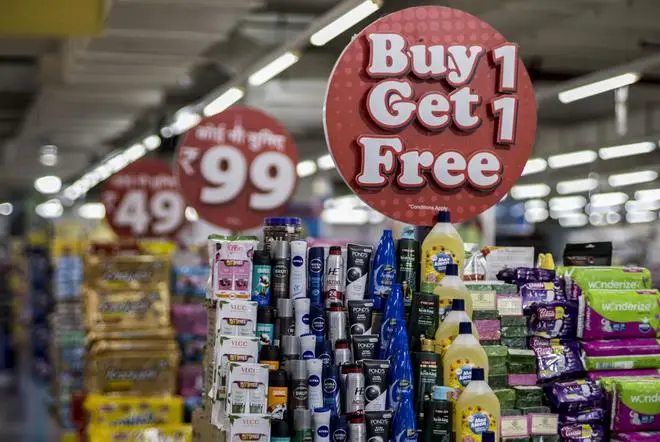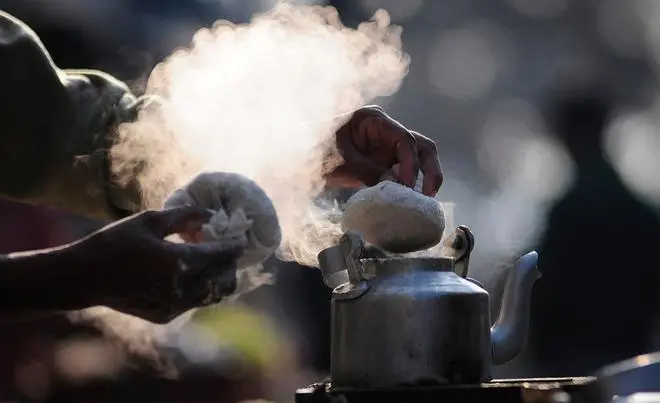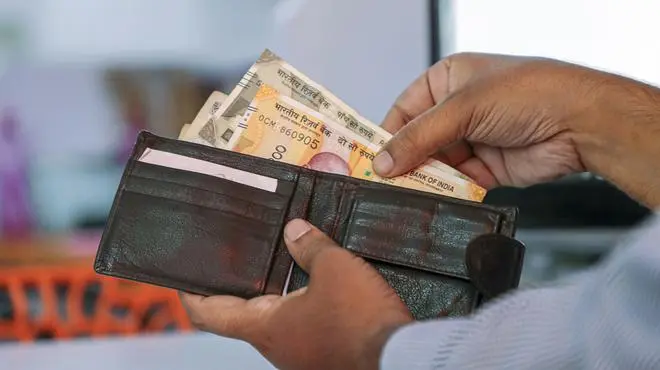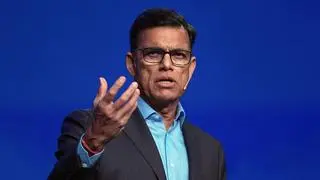Mukund and his family of four in Chennai were big consumers of Britannia’s premium multi-grain bread. Late last year, when Britannia increased the weight of the bread loaf from 400 gm to 450 gm, it also hiked the price from ₹38 to ₹45. Mukund grumbled about the hike, but continued buying the loaf. But, when prices went up to ₹50 a loaf recently, he switched to Modern’s whole wheat bread, which for 400 gm costs ₹40. In the past fortnight or so, the price of the multi-grain loaf has gone up to ₹55.
Or, take the case of Sarojini, a loyal consumer of Marico’s Saffola sunflower oil till recently. When Saffola’s prices zoomed from ₹150 a litre to ₹230 a litre, fuelled by higher commodity prices, she hastily shifted to a cheaper brand of oil. Marico’s update for Q1 of FY23, validates what scores of consumers like Sarojini are doing, and what for FMCG companies are two dreaded words: inflation and downtrading.
“Saffola oils declined in double digits, having to contend with high in-home consumption in the base quarter and significant downtrading visible from super-premium to mass segment in edible oils,” said Marico.

Discount signage inside a supermarket in New Delhi, India, on Sunday July 10, 2022. India is scheduled to release consumer price index (CPI) figures on July 12. Photographer: Anindito Mukherjee/Bloomberg | Photo Credit: ANINDITO MUKHERJEE
Demand slows
Across a swathe of industries, from FMCG to two-wheelers, branded garments and footwear and services, India Inc is banking on the consumption story to drive growth, given that India is predominantly a consumption-driven economy. But it may be tough going. Private final consumption expenditure (PFCE) for the last fiscal year was projected to be ₹140 trillion, or 59.3 per cent of GDP, which as percentage share of GDP, is lower than the 61 per cent in pre-pandemic FY20. There’s a lot to pinch the household budget, especially down the pyramid, from rising fuel prices to higher commodity prices, though, paradoxically, at the upper end, car sales are zooming, as is travel spending.

NEW DELHI, 29/03/2022: A scene at one of the petrol filling, even as the price of petrol (Rs 100.21 per litre) and diesel ( Rs 91.47) were hiked yet again across the country for the fifth successive day, in New Delhi on March 29, 2022. Photo: Sushil Kumar Verma/ The Hindu | Photo Credit: SUSHIL KUMAR VERMA
Rural demand flagging is also a matter of concern. Says the CEO of a large FMCG company, off the record, “There is definitely value-seeking, household budgets are being stretched; 5-20 per cent price increases have been taken in branded goods. So, hikes across the board from commodities, consumables, fuel, will stretch consumer budgets; downtrading is happening, people are switching to smaller packs and seeking better value in whatever they buy.” The shopper’s pocket is buffeted, he explains, especially where food inflation is concerned. “If you look at the Indian consumption basket, 50 per cent of that is food and it’s seeing an inflation of anything from 12-15 per cent and that means budgets are stretched 6-10 per cent. Then you have fuel, electricity, education and travel, all are going up; on average, there is clearly a 15-20 per cent stretch in household budgets while salaries are not going up that much.”

Rural demand is also falling | Photo Credit: RITU RAJ KONWAR
Sachchidanand Shukla, Chief Economist, Mahindra & Mahindra, says the RBI's May 22 consumer confidence survey shows that the current situation index rose by 6 per cent MoM and 52 per cent YoY. However, it is still 9 per cent below the pre-pandemic level. “Even though per capita income has recovered, the bottom of the pyramid segment is witnessing muted recovery. With a forecast of a fourth successive ‘normal’ monsoon, higher realisations and government’s emphasis on public infrastructure investments should cushion rural demand,” he says. Moreover, with supply side measures from the government such as excise duty cuts on fuels and reduced import duties on raw materials like ferronickel and coal to contain inflation along with higher fertiliser subsidies and extension of the free food scheme should help alleviate some of the pain at the bottom of the pyramid on both rural as well as urban side, explains Shukla.
Cloudy Outlook
Naushad Forbes, Co-Chairman of Forbes Marshall and former CII President, says, in the short term, India has seen substantive recovery to aid the consumption story. “Despite question marks on the rupee and the inflation rate, broadly India is in a better shape than much of the world,” he says. But, it’s the medium term outlook that he’s worried about. “There is concern over employment and rural demand – both have not recovered. We are still seeing, after the pandemic, there seem to be 20 million fewer jobs than two and a half years ago. Unless we see substantial recovery in rural volumes, and urban employment, where will sustained growth in demand come from which will lift all boats with it and take the economy forward?”
Deepak Jasani, Head of retail research, HDFC Securities, believes urban consumption so far has been resilient except for some pockets of downtrading seen. If the inflation continues at high levels for some more months, then due to second order effects even the urban population could come under pressure and offtake could get impacted, he explains. “As far as rural offtake is concerned, a lot would depend on the spread and intensity of monsoon this year as a good outcome could improve sentiments and help kick off a consumption cycle aided by already higher crop realisations. High inflation could delay this revival but cannot postpone it beyond a point in time,” he says.
Resilient economy
However, Hetal Gandhi, Director, Crisil Research, says the urban demand sentiment remains positive as urban salaries influenced by IT sector payouts and recruitment drives, banking and other industrial sectors are sustaining the momentum with hikes. “Corporate India accounts for a fourth of total incomes generated in the country. An analysis of 40,000 companies with a wage bill of ₹12 lakh crore would be more than 50 per cent of incomes generated from corporate India employment. These companies are set to see a continued 15 per cent plus rise in employee payouts – a combination of new recruitment and plus higher salaries,” she says. This will ensure urban demand does not flag.
Charath Narasimhan, Managing Director of Indian Terrain Fashions, says the brand has seen a significant uptick in FY 22-23 first quarter sales as compared to last year’s comparable quarter. “I see positives, as we are a consumption story and as long as it remains reasonably buoyant, we are in a good place because the manufacturing boost of the government will kick in; it will take three to four years to see the impact of this. If inflation is kept within a reasonable range then we are okay. Steady and accessible pricing of staples is the biggest factor as it allows for greater disposable incomes and inflation has to be in a reasonable band for that,” he explains. Narasimhan says if one were to compare to a decade ago, it was a situation of high inflation, poor corporate balance sheets and weakening rupee. “It was a terrible place to be in. Today, inflation is probably at that level, but balance sheets are stronger,” he adds.

Inflation is eating into disposable income | Photo Credit: Arnav Pratap Singh
However, the FMCG company chief quoted earlier is concerned about inflation. “My belief is that this economy is driven by consumption and if you look at some of the base indicators, GST collections or Purchasing Managers’ Index, or employment numbers being generated in the blue collar segment, these are all positive so far. The only joker in the pack is inflation and how much it will bite off the consumer’s purchasing basket,” he says.The latest figures show that retail inflation is still stuck above the 7 per cent mark for the third straight month. Rural inflation edged up to 7.09 per cent while urban consumers faced a 6.92 per cent price rise as per the CPI released recently. India Inc will be watching these figures carefully.
(With reports from Surabhi)







Comments
Comments have to be in English, and in full sentences. They cannot be abusive or personal. Please abide by our community guidelines for posting your comments.
We have migrated to a new commenting platform. If you are already a registered user of TheHindu Businessline and logged in, you may continue to engage with our articles. If you do not have an account please register and login to post comments. Users can access their older comments by logging into their accounts on Vuukle.